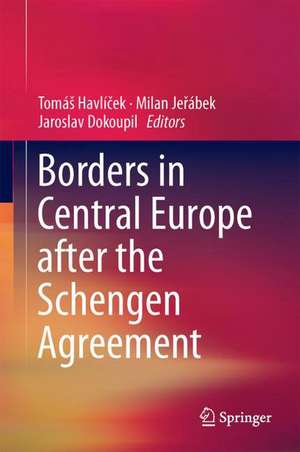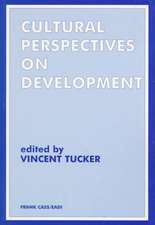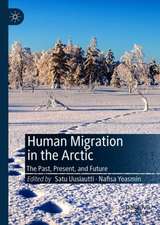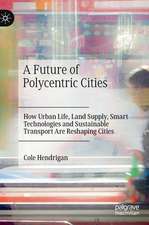Borders in Central Europe After the Schengen Agreement
Editat de Tomáš Havlíček, Milan Jeřábek, Jaroslav Dokoupilen Limba Engleză Hardback – 2 oct 2017
| Toate formatele și edițiile | Preț | Express |
|---|---|---|
| Paperback (1) | 556.10 lei 38-44 zile | |
| Springer International Publishing – 12 iun 2018 | 556.10 lei 38-44 zile | |
| Hardback (1) | 569.00 lei 38-44 zile | |
| Springer International Publishing – 2 oct 2017 | 569.00 lei 38-44 zile |
Preț: 569.00 lei
Preț vechi: 711.25 lei
-20% Nou
Puncte Express: 854
Preț estimativ în valută:
108.91€ • 118.34$ • 91.55£
108.91€ • 118.34$ • 91.55£
Carte tipărită la comandă
Livrare economică 18-24 aprilie
Preluare comenzi: 021 569.72.76
Specificații
ISBN-13: 9783319630151
ISBN-10: 3319630156
Pagini: 239
Ilustrații: X, 239 p. 40 illus., 6 illus. in color.
Dimensiuni: 155 x 235 mm
Greutate: 0.55 kg
Ediția:1st ed. 2018
Editura: Springer International Publishing
Colecția Springer
Locul publicării:Cham, Switzerland
ISBN-10: 3319630156
Pagini: 239
Ilustrații: X, 239 p. 40 illus., 6 illus. in color.
Dimensiuni: 155 x 235 mm
Greutate: 0.55 kg
Ediția:1st ed. 2018
Editura: Springer International Publishing
Colecția Springer
Locul publicării:Cham, Switzerland
Cuprins
Introduction (Milan Jeřábek).- Part I: European Integration, Borderlands and Schengen.- Chapter 1. Changing European Union: the Schengen Agreement (Petr Dostal).- Chapter 2. The Development of Borderlands as a Part of European Process of Integration (Jaroslav Dokoupil).- Chapter 3. Phenomenon of Schengen – Fact or Fiction? (Tomáš Havlíček).- Chapter 4. Euroregions as a Platform for Cross-Border Cooperation (Milan Jeřábek).- Chapter 5. Institutionalisation of Cross-Border Cooperation: the Role of the Association of European Border regions (Martín Guillermo Ramirez).- Part II: Case Studies - Internal and External Schengen Borders.- Chapter 6. The Example of Swiss Borderland with a Focus on Euregio Basiliensis/Tri Rhena (DE/FR/CH) (Walter Leimgruber).- Chapter 7. Development of the Slovak Borderlands with an Emphasis on the Situation after Schengen: internal and external borders (Marian Halás).- Chapter 8. Eastern Borderland of the Baltic States as the External
Border of Schengen (Josef Miškovsk).- Chapter 9. Silesian Identity across the Internal Borders of the EU (Tadeusz Siwek).- Part III: Research in the Model Euroregions on the Czech Borderlands.- Chapter 10. The Quality of Life and Cross-Border Relation in Selected Czech Euroregions (Alena Matušková).- Chapter 11. The Building of Cross-Border Region Using the Example Euroregion Silva Nortica - on the Way from Closed to Open Borders (Tomáš Havlíček).- Chapter 12. Cross-Border Community Expression of Open Civil Society on the Example of the Euroregion Elbe/Labe (František Zich ).- Chapter 13. Conclusions: The borderlands after Schengen – self-sufficient, oscillatory and/or transit regions? (Milan Jeřábek).
Border of Schengen (Josef Miškovsk).- Chapter 9. Silesian Identity across the Internal Borders of the EU (Tadeusz Siwek).- Part III: Research in the Model Euroregions on the Czech Borderlands.- Chapter 10. The Quality of Life and Cross-Border Relation in Selected Czech Euroregions (Alena Matušková).- Chapter 11. The Building of Cross-Border Region Using the Example Euroregion Silva Nortica - on the Way from Closed to Open Borders (Tomáš Havlíček).- Chapter 12. Cross-Border Community Expression of Open Civil Society on the Example of the Euroregion Elbe/Labe (František Zich ).- Chapter 13. Conclusions: The borderlands after Schengen – self-sufficient, oscillatory and/or transit regions? (Milan Jeřábek).
Notă biografică
Tomáš Havlíček is Assistant Professor at the Department of Social Geography and Regional Development, Faculty of Science at the Charles University in Prague, Czechia. His research is concerned with the geography of border and peripheral regions, geography of religion and cultural geography. He is member of the main committee of Czech Geographic Society. He is also collaborator of the workgroup on geography of religion by the German Geographical Society. He is interested also in border areas in Europe and in particular the Czech-Austrian borderland. He has published many articles concerning cross-border cooperation in Central Europe.
Milan Jeřábek is Associated Professor at the Department of Geography at the Masaryk University in Brno, Czechia. The scope of his research lies in Geography of Population and Settlement, Regional Planning, Regional Development and policy, especially Geography of Border Studies. He has led many projects dealing with the study of border and cross-border cooperation. He is also a member of the editorial board of the book series “Geographica” published by the Czech Geographic Society and a co-chair of professional working group for regional development of the Elbe/Labe Euroregion.Jaroslav Dokoupil is Associated Professor at the Department of Geography at the Faculty of Economics at the University of West Bohemia in Plzeň. He is a member of the Centre for Regional Development Research. He deals with regional geography and regional planning. In terms of his research activities, he focuses on the borderland of Czechia, specifically on the Czech-Bavarian borderland and on peripheral areas and Euroregions in the context of European regional policy.
Milan Jeřábek is Associated Professor at the Department of Geography at the Masaryk University in Brno, Czechia. The scope of his research lies in Geography of Population and Settlement, Regional Planning, Regional Development and policy, especially Geography of Border Studies. He has led many projects dealing with the study of border and cross-border cooperation. He is also a member of the editorial board of the book series “Geographica” published by the Czech Geographic Society and a co-chair of professional working group for regional development of the Elbe/Labe Euroregion.Jaroslav Dokoupil is Associated Professor at the Department of Geography at the Faculty of Economics at the University of West Bohemia in Plzeň. He is a member of the Centre for Regional Development Research. He deals with regional geography and regional planning. In terms of his research activities, he focuses on the borderland of Czechia, specifically on the Czech-Bavarian borderland and on peripheral areas and Euroregions in the context of European regional policy.
Textul de pe ultima copertă
This book is the result of research into the considerable impacts the signing of the Schengen Agreement has had on the border regions of the signatory, in particular the Central European internal borders. The analysis provides an in-depth look at European integration, development and perception at the state level as well as in the selected border regions of Central Europe. The book discusses results from population questionnaires in this region, and presents the most important features of development of border regions within Central European internal borders/borderlands after the Schengen Agreement. This book is suitable for students and researchers dealing with the borderlands, but also outlines sufficient information to be of interest to regional planners and policy makers.
Caracteristici
Offers new conceptual features to the border regions within the Schengen countries Unique methodology (questionnaires) offer insight into the role of Schengen in Central Europe Compares the of results by many border regions in Central Europe

























